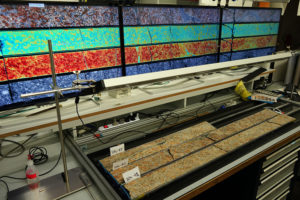Chicxulub Impact Crater Expedition Recovers Core to Further Discovery on the Impact on Life and the Historical Dinosaur Extinction
From April to May 2016, a team of international scientists drilled into the site of an asteroid impact, known as the Chicxulub Impact Crater, which occurred 66 million years ago. The crater is buried several hundred meters below the surface in the Yucatán region of Mexico. Until that time, dinosaurs and marine reptiles dominated the world, but the series of catastrophic events that followed the impact caused the extinction of all large animals, leading to the rise of mammals and evolution of mankind. This joint expedition, organized by the International Ocean Discovery Program (IODP) and International Continental Scientific Drilling Program (ICDP) recovered a nearly complete set of rock cores from 506 to 1335 meters below the modern day seafloor. These cores are now being studied in detail by an international team of scientists to understand the effects of the impact on life and as a case study of how impacts affect planets.
CT Scans of Cores Provide Deeper Insight Into Core Description and Analysis
Before being shipped to Germany (where the onshore science party took place from September to October 2016), the cores were sent to Houston, TX for CT scanning and imaging. The scanning was done at Weatherford Labs, who performed a high resolution dual energy scan on the entire core. Dual energy scanning utilizes x-rays at two different energy levels. This provides the information necessary to calculate the bulk density and effective atomic numbers of the core. Enthought processed the raw CT data, and provided cleaned CT data along with density and effective atomic number images. The expedition scientists were able to use these images to assist with core description and analysis.

These images are helping scientists understand the processes that occurred during the impact, how the rock was damaged, and how the properties of the rock were affected. From analysis of images, well log data and laboratory tests it appears that the impact had a permanent effect on rock properties such as density, and the shattered granite in the core is yielding new insights into the mechanics of large impacts.
Virtual Core Provides Co-Visualization of CT Data with Well Log Data, Borehole Images, and Line Scan Photographs for Detailed Interrogation
Enthought’s Virtual Core software was used by the expedition scientists to integrate the CT data along with well log data, borehole images and line scan photographs. This gave the scientists access to high resolution 2D and 3D images of the core, and allowed them to quickly interrogate regions in more detail when questions arose. Virtual Core also provides machine learning feature detection intelligence and visualization capabilities for detailed insight into the composition and structure of the core, which has proved to be a valuable tool both during the onshore science party and ongoing studies of the Chicxulub core.
Enthought’s Virtual Core software was used by the expedition scientists to visualize the CT data alongside well log data, borehole images and line scan photographs.
Related Articles
Drilling to Doomsday
Discover Magazine, October 27, 2016
Chicxulub ‘dinosaur crater’ investigation begins in earnest
BBC News, October 11, 2016
How CT scans help Chicxulub Crater scientists
Integrated Ocean Drilling Program (IODP) Chicxulub Impact Crater Expedition Blog, October 3, 2016
Chicxulub ‘dinosaur’ crater drill project declared a success
BBC Science, May 25, 2016
Related Content
Digital Transformation vs. Digital Enhancement: A Starting Decision Framework for Technology Initiatives in R&D
Leveraging advanced technology like generative AI through digital transformation (not digital enhancement) is how to get the biggest returns in scientific R&D.
Digital Transformation in Practice
There is much more to digital transformation than technology, and a holistic strategy is crucial for the journey.
Leveraging AI for More Efficient Research in BioPharma
In the rapidly-evolving landscape of drug discovery and development, traditional approaches to R&D in biopharma are no longer sufficient. Artificial intelligence (AI) continues to be a...
Utilizing LLMs Today in Industrial Materials and Chemical R&D
Leveraging large language models (LLMs) in materials science and chemical R&D isn't just a speculative venture for some AI future. There are two primary use...
Top 10 AI Concepts Every Scientific R&D Leader Should Know
R&D leaders and scientists need a working understanding of key AI concepts so they can more effectively develop future-forward data strategies and lead the charge...
Why A Data Fabric is Essential for Modern R&D
Scattered and siloed data is one of the top challenges slowing down scientific discovery and innovation today. What every R&D organization needs is a data...
Jupyter AI Magics Are Not ✨Magic✨
It doesn’t take ✨magic✨ to integrate ChatGPT into your Jupyter workflow. Integrating ChatGPT into your Jupyter workflow doesn’t have to be magic. New tools are…
Top 5 Takeaways from the American Chemical Society (ACS) 2023 Fall Meeting: R&D Data, Generative AI and More
By Mike Heiber, Ph.D., Materials Informatics Manager Enthought, Materials Science Solutions The American Chemical Society (ACS) is a premier scientific organization with members all over…
Real Scientists Make Their Own Tools
There’s a long history of scientists who built new tools to enable their discoveries. Tycho Brahe built a quadrant that allowed him to observe the…
How IT Contributes to Successful Science
With the increasing importance of AI and machine learning in science and engineering, it is critical that the leadership of R&D and IT groups at...